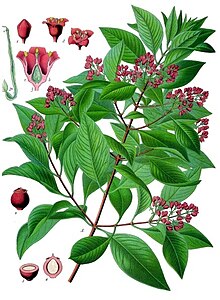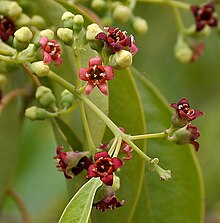Sandalwood tree
| Sandalwood tree | ||||||||||||
|---|---|---|---|---|---|---|---|---|---|---|---|---|

Sandalwood tree ( Santalum album ) |
||||||||||||
| Systematics | ||||||||||||
|
||||||||||||
| Scientific name | ||||||||||||
| Santalum album | ||||||||||||
| L. |
The sandalwood tree ( Santalum album ) also white sandalwood , white sandalwood , is a plant species within the family of viscaceae (Santalaceae). The original range of this semi-parasite is unknown. The sandalwood tree is grown and used in many tropical areas in many tropical areas.
description
Appearance and leaf
The sandalwood tree grows as an evergreen, small tree that reaches heights of growth of up to 4 meters in Australia and up to 20 meters in India. The cylindrical trunk can reach a circumference of over 1.5 meters. Sometimes it also grows as an upright or rarely climbing shrub that can reach heights of up to 4 meters. The above-ground parts of the plant are bare. In young trees, the bark is smooth and reddish to dark brown, dark gray to almost black. In older specimens, the bark has deep vertical cracks and is red inside. The lower branches are sometimes overhanging. The branches are slightly angular and grooved.
The leaves, which are usually opposite or sometimes cross-opposite on the branches, are divided into a petiole and a leaf blade. The relatively thin, yellowish leaf stalks are 5 to 15 cm long and have two furrows. The relatively thin, simple leaf blade is seldom 2.5 to, usually 3 to 8 centimeters in length and rarely 1.5 to, usually 3 to 5 centimeters in width, ovoid to elliptical, lanceolate or oblong with blunt, wedge-shaped or pointed Spreading base and rounded to pointed upper end. The leaf margin is whole and sometimes wavy or slightly bent back. The upper side of the leaf is shiny and the underside is somewhat paler and blue-green. There are six to ten lateral nerves on each side of the median nerve. The network nerves are clearly visible.
Inflorescence and flower
In terminal or lateral inflorescence shafts that are 4 to 20 millimeters long, paniculate or racemose , zymous 2 to 5 centimeters long total inflorescences are small clusters with up to six flowers each. The bracts fall off early. The flower stalk is no more than 3 millimeters long.
The odorless, hermaphrodite flowers are 4 to 6 millimeters long and usually four, rarely five-fold. The bracts are initially straw-colored, yellowish, green and turn reddish or purple in color. The mostly four bracts are fused together over a length of about 2 millimeters in a bell-shaped manner and the free area is triangular-ovoid. Behind the mostly four stamens there are tufts of hair that are as long as these. There are usually four nectar glands in the middle of the perianthral tube . The discus has four raised upright, recurved, 1.2 to 1.5 millimeters long, fleshy lobes that initially turn orange-brown and turn blackish-red. The ovary is above or half below. The short style ends in a small, easy three-lobed stigma .
Fruit and seeds
The almost sessile, lonely stone fruit is spherical or ellipsoidal with a diameter of about 1 centimeter. The fleshy stone fruit has an initially red and, when ripe, purple, blue to blackish-red coloring, smooth exocarp , a hard, slightly wrinkled, smooth, light brown endocarp and it is crowned by a scar. The seeds do not have a seed coat (testa). The thousand grain mass is 97 grams.
Chromosome set
The number of chromosomes is usually 2n = 20, rarely 18.
ecology
Epigeic germination occurs . The semi-parasite (hemiparasite) Santalum album parasitizes on the roots of other tree species in order to supply itself with water and inorganic salts. The host plants include Senna siamea and Drypetes lasiogyna .
In addition to self-pollination , there is also pollination by various insects such as bees, butterflies and beetles. The seeds are mainly distributed by birds that eat the fruit.
The sandalwood tree is susceptible to phytoplasms , which in extreme cases lead to the death of the specimen, while the host plants can be attacked by pathogenic fungi such as Fusarium and Phytophthora .
Occurrence and endangerment
According to PROSEA, the original distribution area is unknown; it is assumed to be on the Outer Bandabogen belonging to southeastern Indonesia , of which Timor and Sumba are the most important islands. According to the IUCN, the natural range of Santalum album ranges from India ( Karnataka , Tamil Nadu ) via China and the Philippines to the Lesser Sunda Islands .
Santalum album thrives in its natural range widely dispersed in deciduous dry forests. In its home areas, Santalum album is rated "Vulnerable" according to the IUCN 1998 Red List of Endangered Species . The main cause of the hazard is considered to be overexploitation.
According to PROSEA, the current occurrence extends from the Bondowoso district in eastern Java eastwards to Timor, Sulawesi , the Moluccas and northern Australia. Today there are cultivation areas of the sandalwood tree in many tropical areas, for example in Sri Lanka , in southern India, in China, Taiwan , Australia and Indonesia.
Taxonomy
The first publication of Santalum album was in 1753 by Carl von Linné in Species Plantarum , 1, p. 349. Synonyms for Santalum album L. are: Sirium myrtifolium L. , Santalum ovatum R.Br. , Santalum myrtifolium (L.) Roxb.
Cultivation and use

The main producer of sandalwood is India . The sandalwood tree begins to bloom for the first time three to four years after planting and it is fully grown after 60 to 80 years. In India the sandalwood tree occurs at altitudes from 0 to 2,500 meters. It thrives best at altitudes between 600 and 1,000 to 1,500 meters. From the age of 15 the sandalwood tree produces around one kilogram of heartwood per year. Suboptimal growth conditions favor a higher proportion of oil in the heartwood. The Santalum album thrives on moist , sandy soils and does not tolerate waterlogging or frost . As a result of overexploitation , the prices for these rose from € 3,800 to € 85,000 per ton between 1990 and 2009.
The light sandalwood is used in the manufacture of perfumes and cosmetic products such as soaps , with sandalwood oil being distilled from the subterranean parts of the plant, the twigs and the heartwood .
The wood is used for carving in Asia .
Sandalwood flour is used as incense .
The fruits are edible. The leaves provide a wax .
symbolism
The old colonial coat of arms Dilis contains the depiction of a sandalwood tree (see here ).
swell
- Santalum album L. - data sheet at PROTA4U.
- Orwa et al., 2009: Santalum album L. Santalaceae at Agroforestry Database 4.0 - full text PDF.
- R. Yusuf, 1999: Santalum album L. at PROSEA = Plant Resources of South-East Asia .
- Henk J. Beentje, PM Polhill: Santalceae. , Flora of Tropical East Africa , Royal Botanic Gardens, Kew, 2005. ISBN 978-1842461136 : Santalum album L., cultivated Sandalwood . on-line.
Individual evidence
- ^ Santalum album in the Germplasm Resources Information Network (GRIN), USDA , ARS , National Genetic Resources Program. National Germplasm Resources Laboratory, Beltsville, Maryland. Retrieved July 17, 2014.
- ↑ a b c d Henk J. Beentje, PM Polhill: Santalceae. , Flora of Tropical East Africa , Royal Botanic Gardens, Kew, 2005. ISBN 978-1842461136 : Santalum album L., cultivated Sandalwood . on-line.
- ↑ a b c d e f g h i j k l m Orwa et al., 2009: Santalum album L. Santalaceae at Agroforestry Database 4.0 - full text PDF.
- ↑ a b c d e f g h i j k l m n o p q r s t u v w x y z aa R. Yusuf, 1999: Santalum album L. at PROSEA = Plant Resources of South-East Asia .
- ↑ Data sheet at Seed Information Database at KEW.
- ↑ Santalum album at Tropicos.org. In: IPCN Chromosome Reports . Missouri Botanical Garden, St. Louis
- ↑ a b Santalum album in the endangered Red List species the IUCN 2014 Posted by: Asian Regional Workshop (Conservation & Sustainable Management of Trees, Viet Nam, August 1996), 1998. Accessed July 17, 2014.
- ↑ Carl von Linné scanned in 1753 at biodiversitylibrary.org .
- ↑ Santalum album at Tropicos.org. Missouri Botanical Garden, St. Louis, accessed July 17, 2014.
- ↑ a b c data sheet at Ecocrop of the FAO = Food and Agriculture Organization of the UN .
- ↑ a b ftd.de (accessed on May 18, 2013) ( Memento from May 10, 2011 in the Internet Archive )
Web links
- Illustration from the Flora of China .
- John Wrigley: Santalum - A Fascinating Genus at Australian Plants online , September 2003.
- The Interaction Between the Hemiparasitic Santalum album and Its Host at South China Botanical Garden , Chinese Academy of Sciences .
- Santalum album on Useful Tropical Plants, accessed November 16, 2018.
further reading
- Danica T. Harbaugh, Bruce G. Baldwin: Phylogeny and biogeography of the sandalwoods (Santalum, Santalaceae): repeated dispersals throughout the Pacific. In: American Journal of Botany , 2007, Volume 94, Issue 6, pp. 1028-1040, doi : 10.3732 / ajb.94.6.1028 .
- JM Johnson: Dispersal of sandalwood (Santalum album) by birds in Tamilnadu. In: Journal of the Bombay Natural History Society. Volume 79, 1981, pp. 672-675.
- Anupama Chembath, M. Balasundaran, P. Sujanapal: Phylogenetic Relationships of Santalum album and its Adulterants as Inferred from Nuclear DNA Sequences. In: International Journal of Agriculture and Forestry. Volume 2, Issue 4, 2012, pp. 150–156, doi : 10.5923 / j.ijaf.20120204.03 .





